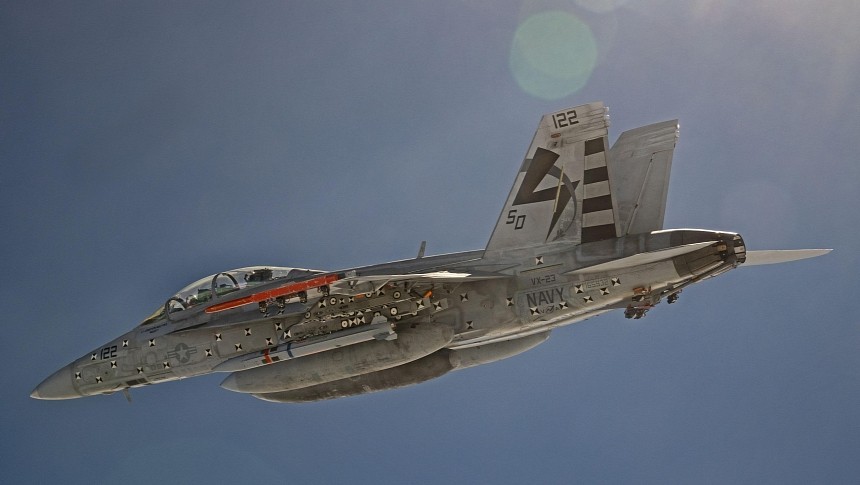It's been several years since we first learned of a new missile for America's fighter aircraft being in the works, the AARGM-ER. But as we step deeper into 2023, we're also getting closer to the time it will finally enter operational service.
AARGM-ER stands for Advanced Anti-Radiation Guided Missile Extended Range. Also known as the AGM-88G, the missile is a product of Northrop Grumman that will eventually be fielded by both U.S. Navy and U.S. Air Force (USAF) fighter jets. We've been watching the development of the weapon ever since 2021, and we've seen it being tested in a variety of environments and situations until now, including during live-fire test and against land-based targets.
This week though we were informed of the AARGM-ER being fired, for the first time, against "operationally-representative modern air defense system targets" located inland. We're not given any details as to where the test took place, but we do know it was a complete success, and the missile "successfully detected, identified, located and engaged an advanced, land-based, emitter target."
"AARGM-ER once again demonstrated high-speed employment of lethal effects against an air defense system target. This is another successful step in our government-industry team's effort to deliver this critically needed capability to our warfighters," said in a statement U.S. Navy CAPT Alex Dutko, Navy program manager.
The secret of the new missile lies in its name. By using special equipment it is capable of locking in on radar electronic transmissions from the surface. When it hits, a blast/fragmentation warhead obliterates the target.
The Extended Range particle in the name is key though for this weapon. Compared to the existing design, which can strike targets located sixty miles (97 km) away, this one should reach double the distance.
The increase in range should allow America's aviators to strike enemy targets while remaining well beyond the reach of most defensive systems. That's possible thanks to a new propulsion system whose exact capabilities were not disclosed. In the current configuration the AARGM can hit speeds of Mach 1.8 (2,280 kph/1,420 mph).
Its design is a bit different from the standard variant as well, with a new, straked airframe replacing the existing mid-body wings presently in use.
In October 2021, while the missile was still in early testing stages, it was cleared for production. It will eventually make it under the wings of the Navy-operated F/A-18E/F Super Hornets and EA-18G Growlers, but also on all variants of the F-35 currently in operation with various branches of the American military.
Now that this fifth consecutive and crucial test has been completed, Northrop Grumman is expected to move ahead with the integration of the weapon. Deliveries to American forces are expected to begin later this year, with initial operational capability for the U.S. Navy expected next year.
This week though we were informed of the AARGM-ER being fired, for the first time, against "operationally-representative modern air defense system targets" located inland. We're not given any details as to where the test took place, but we do know it was a complete success, and the missile "successfully detected, identified, located and engaged an advanced, land-based, emitter target."
"AARGM-ER once again demonstrated high-speed employment of lethal effects against an air defense system target. This is another successful step in our government-industry team's effort to deliver this critically needed capability to our warfighters," said in a statement U.S. Navy CAPT Alex Dutko, Navy program manager.
The secret of the new missile lies in its name. By using special equipment it is capable of locking in on radar electronic transmissions from the surface. When it hits, a blast/fragmentation warhead obliterates the target.
The Extended Range particle in the name is key though for this weapon. Compared to the existing design, which can strike targets located sixty miles (97 km) away, this one should reach double the distance.
The increase in range should allow America's aviators to strike enemy targets while remaining well beyond the reach of most defensive systems. That's possible thanks to a new propulsion system whose exact capabilities were not disclosed. In the current configuration the AARGM can hit speeds of Mach 1.8 (2,280 kph/1,420 mph).
Its design is a bit different from the standard variant as well, with a new, straked airframe replacing the existing mid-body wings presently in use.
In October 2021, while the missile was still in early testing stages, it was cleared for production. It will eventually make it under the wings of the Navy-operated F/A-18E/F Super Hornets and EA-18G Growlers, but also on all variants of the F-35 currently in operation with various branches of the American military.
Now that this fifth consecutive and crucial test has been completed, Northrop Grumman is expected to move ahead with the integration of the weapon. Deliveries to American forces are expected to begin later this year, with initial operational capability for the U.S. Navy expected next year.






